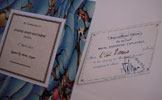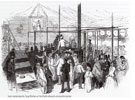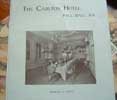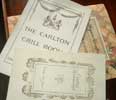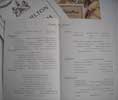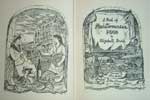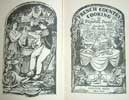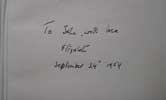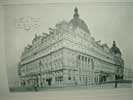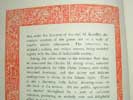A letter to P. Andrieu, signed by Escoffier.
A two page letter written at his retirement home in Monte-Carlo, 20 November, 1934
Addressed to Monsieur P(ierre) Andrieu, --- Paris. The two pages are covered in Escoffier's handwriting. There is also a one page English translation of the letter. A very clean item. Enclosed in a neat marbled cardboard folder. With a label on the front cover. The letter is from the library of Pierre Orsi, the famous Lyon restuaranteur. A rare item.
- The letter is written one year before Escoffier's death. He writes in a rather shaky hand -- [Dear Sir, I am very surprised that you did not receive my letter which was in answer to yours, whereby you were asking me to write an article for the newspaper "L'action automobile". This article should have been about regional cuisine as seen from the point of view of the chef - Curnonsky treats it from the point of view of the gastronome. Between the chef and Curnonsky there is a wide gap that I do not wish to bridge. Mr Curnonsky speaks as a writer, he is charming and his articles are interesting in places but I have no desire to be the cause of any arguments. To answer your question, I could only do it after reading the article "les princes de la cuisine francaise". Despite all my desire to be agreeable to you and Mr Roussel, it will be impossible for me to do it. I must also tell you that the different regional cuisines do not exist anymore. Ever since all the "regions" have been merged by the advance of the automobile which created easier access from one country to another, we have now in France only one cuisine and that is French Cuisine. -- With deepest regret for not acceding to your wishes, Yours sincerely, A. Escoffier. -- My best wishes to Mr Roussel.] Pierre Andrieu was an author of many articles and books in the domain of wine and gastronomy. He was also a collaborator of Curnonsky's. Together they published in 1935 a book about the restaurants of France, titled 'Les Fines Gueules de France'. This letter pertains to the research for that book. Maurice Edmond Sailland (October 12, 1872, Angers, France – July 22, 1956, Paris), better known by his pen-name Curnonsky and dubbed the Prince of Gastronomy, was the most celebrated writer on gastronomy in France in the 20th century. He wrote or ghost-wrote over 65 books and enormous numbers of newspaper columns. He is often considered the inventor of gastronomic motor-tourism as popularized by Michelin, though he himself could not drive. The contents of the letter display an ironic point of interest. Escoffier, one year before his death is offering a glimpse of the changes he is seeing to his beloved French cuisine. Having re-organised, during his life time, the French kitchen so fundamentally from that of the Bel-Epoque era he is still only really interested in viewing the changes from the chef's point of view. It is obvious that even at the grand old age of eighty eight, he is still active and well informed.



click on image to enlarge

Ephemera category
ref number:
10989 

